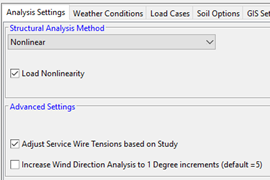Analysis Settings
The Nonlinear Structural Analysis Method is the default for Quick Pole to use. However, it is also possible to do just a Linear Analysis by selecting this default choice. These default choices can later be overridden on a per structure basis.

Specific to the Nonlinear Analysis method is one additional option - Load Nonlinearity.
Load Nonlinearity - In addition to performing a Nonlinear Analysis, this option additionally considers the movement of the Structure and its effects on the stretching/slackening of span wire attachments and the corresponding impact on the tensions/forces that they exert onto the pole. This feature is optimized to consider several connected structures deflecting at the same time, which is considered "Best in Class" and is similar to PLS-CADD's Level 4 analysis considering 3 adjacent structures in each direction.
Adjust Service Wire tensions based on Study - There was a study of power service wire tensions completed by Bell Canada in Ontario in 2014. Through that study it was confirmed that most power service wires are not tensioned to the maximum amount allowed in the Power Utility's standards unless required to meet clearance requirements. In most cases for span less than 30 meters, the wires on average are placed to create about 0.4 meters of vertical sag below the building attachment point; and that the average height of the power wire on the pole was 2.0 meters above the building's attachment point. If this option is selected, Power Service Wires and Communication Service Wires will be tensioned to create this desired sag profile. If the required tension to accomplish this is greater than the Power utility's standards, the standard value is used as the limit. Communication Service Wires are typically sagged the same way as that it is standard practice for communication wires to follow the sag profile of the Power wires in the same span to Buildings.
Increase Wind Direction Analysis to 1 Degree Increments - This option is not recommended, but available, as it drastically increases analysis time for most projects. By selecting this option you will force Quick Pole to perform a Structural Analysis of each pole with the wind assumed to move around the pole in one degree increments (5 is the default), for all Load Cases that involve wind. This option is not normally necessary, but remains for increased confidence that the 5 degree increment results are sufficiently accurate.